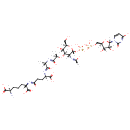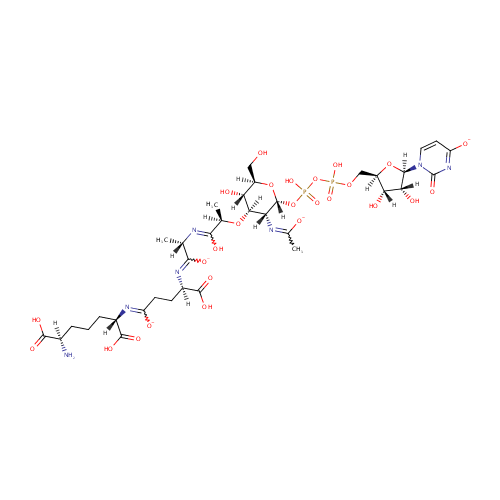
UDP-N-Acetylmuramoyl-L-alanyl-D-glutamyl-meso-2,6-diaminoheptanedioate (PAMDB000650)
| Record Information | ||||||||||||||||||||||||||||||||||||||||||||||||||||||||||
|---|---|---|---|---|---|---|---|---|---|---|---|---|---|---|---|---|---|---|---|---|---|---|---|---|---|---|---|---|---|---|---|---|---|---|---|---|---|---|---|---|---|---|---|---|---|---|---|---|---|---|---|---|---|---|---|---|---|---|
| Version | 1.0 | |||||||||||||||||||||||||||||||||||||||||||||||||||||||||
| Update Date | 1/22/2018 11:54:54 AM | |||||||||||||||||||||||||||||||||||||||||||||||||||||||||
| Metabolite ID | PAMDB000650 | |||||||||||||||||||||||||||||||||||||||||||||||||||||||||
| Identification | ||||||||||||||||||||||||||||||||||||||||||||||||||||||||||
| Name: | UDP-N-Acetylmuramoyl-L-alanyl-D-glutamyl-meso-2,6-diaminoheptanedioate | |||||||||||||||||||||||||||||||||||||||||||||||||||||||||
| Description: | UDP-n-acetylmuramoyl-L-alanyl-D-glutamyl-meso-2,6-diaminoheptanedioate is a member of the chemical class known as Peptides. These are compounds containing an amide derived from two or more amino carboxylic acid molecules (the same or different) by formation of a covalent bond from the carbonyl carbon of one to the nitrogen atom of another. It is a key component of peptidoglycan synthesis. The peptidoglycan synthesis pathway starts at the cytoplasm, where in six steps the peptidoglycan precursor a UDP-N-acetylmuramoyl-pentapeptide is synthesized. This precursor is then attached to the memberane acceptor all-trans-undecaprenyl phosphate, generating a N-acetylmuramoyl-pentapeptide-diphosphoundecaprenol, also known as lipid I. Another transferase then adds UDP-N-acetyl-alpha-D-glucosamine, yielding the complete monomeric unit a lipid , also known as lipid . This final lipid intermediate is transferred through the membrane. The peptidoglycan monomers are then polymerized on the outside surface by glycosyltransferases, which form the linear glycan chains, and transpeptidases, which catalyze the formation of peptide crosslinks. | |||||||||||||||||||||||||||||||||||||||||||||||||||||||||
| Structure | ||||||||||||||||||||||||||||||||||||||||||||||||||||||||||
| Synonyms: |
| |||||||||||||||||||||||||||||||||||||||||||||||||||||||||
| Chemical Formula: | C35H51N7O26P2 | |||||||||||||||||||||||||||||||||||||||||||||||||||||||||
| Average Molecular Weight: | 1047.7583 | |||||||||||||||||||||||||||||||||||||||||||||||||||||||||
| Monoisotopic Molecular Weight: | 1047.235897863 | |||||||||||||||||||||||||||||||||||||||||||||||||||||||||
| InChI Key: | QUHLBZKCGUXHGP-BHBBPGSKSA-J | |||||||||||||||||||||||||||||||||||||||||||||||||||||||||
| InChI: | InChI=1S/C35H55N7O26P2/c1-13(28(50)40-18(33(56)57)7-8-21(45)39-17(32(54)55)6-4-5-16(36)31(52)53)37-29(51)14(2)64-27-23(38-15(3)44)34(66-19(11-43)25(27)48)67-70(61,62)68-69(59,60)63-12-20-24(47)26(49)30(65-20)42-10-9-22(46)41-35(42)58/h9-10,13-14,16-20,23-27,30,34,43,47-49H,4-8,11-12,36H2,1-3H3,(H,37,51)(H,38,44)(H,39,45)(H,40,50)(H,52,53)(H,54,55)(H,56,57)(H,59,60)(H,61,62)(H,41,46,58)/p-4/t13-,14+,16+,17-,18+,19+,20+,23+,24+,25+,26+,27+,30+,34+/m0/s1 | |||||||||||||||||||||||||||||||||||||||||||||||||||||||||
| CAS number: | Not Available | |||||||||||||||||||||||||||||||||||||||||||||||||||||||||
| IUPAC Name: | (4R)-N-[(1S,5R)-5-amino-1,5-dicarboxypentyl]-4-carboxy-4-{[(2S)-2-{[(2R)-2-{[(2R,3R,4R,5S,6R)-2-({[({[(2R,3S,4R,5R)-3,4-dihydroxy-5-(4-oxido-2-oxo-1,2-dihydropyrimidin-1-yl)oxolan-2-yl]methoxy}(hydroxy)phosphoryl)oxy](hydroxy)phosphoryl}oxy)-5-hydroxy-6-(hydroxymethyl)-3-[(1-oxidoethylidene)amino]oxan-4-yl]oxy}-1-hydroxypropylidene]amino}-1-oxidopropylidene]amino}butanecarboximidate | |||||||||||||||||||||||||||||||||||||||||||||||||||||||||
| Traditional IUPAC Name: | (4R)-N-[(1S,5R)-5-amino-1,5-dicarboxypentyl]-4-carboxy-4-{[(2S)-2-{[(2R)-2-{[(2R,3R,4R,5S,6R)-2-[({[(2R,3S,4R,5R)-3,4-dihydroxy-5-(4-oxido-2-oxopyrimidin-1-yl)oxolan-2-yl]methoxy(hydroxy)phosphoryl}oxy(hydroxy)phosphoryl)oxy]-5-hydroxy-6-(hydroxymethyl)-3-[(1-oxidoethylidene)amino]oxan-4-yl]oxy}-1-hydroxypropylidene]amino}-1-oxidopropylidene]amino}butanecarboximidate | |||||||||||||||||||||||||||||||||||||||||||||||||||||||||
| SMILES: | [H][C@@](N)(CCC[C@]([H])(N=C([O-])CC[C@@]([H])(N=C([O-])[C@]([H])(C)N=C(O)[C@@]([H])(C)O[C@@]1([H])[C@]([H])(O)[C@@]([H])(CO)O[C@]([H])(OP(O)(=O)OP(O)(=O)OC[C@@]2([H])O[C@@]([H])(N3C=CC([O-])=NC3=O)[C@]([H])(O)[C@]2([H])O)[C@]1([H])N=C(C)[O-])C(O)=O)C(O)=O)C(O)=O | |||||||||||||||||||||||||||||||||||||||||||||||||||||||||
| Chemical Taxonomy | ||||||||||||||||||||||||||||||||||||||||||||||||||||||||||
| Taxonomy Description | This compound belongs to the class of organic compounds known as pyrimidine nucleotide sugars. These are pyrimidine nucleotides bound to a saccharide derivative through the terminal phosphate group. | |||||||||||||||||||||||||||||||||||||||||||||||||||||||||
| Kingdom | Organic compounds | |||||||||||||||||||||||||||||||||||||||||||||||||||||||||
| Super Class | Nucleosides, nucleotides, and analogues | |||||||||||||||||||||||||||||||||||||||||||||||||||||||||
| Class | Pyrimidine nucleotides | |||||||||||||||||||||||||||||||||||||||||||||||||||||||||
| Sub Class | Pyrimidine nucleotide sugars | |||||||||||||||||||||||||||||||||||||||||||||||||||||||||
| Direct Parent | Pyrimidine nucleotide sugars | |||||||||||||||||||||||||||||||||||||||||||||||||||||||||
| Alternative Parents |
| |||||||||||||||||||||||||||||||||||||||||||||||||||||||||
| Substituents |
| |||||||||||||||||||||||||||||||||||||||||||||||||||||||||
| Molecular Framework | Aromatic heteromonocyclic compounds | |||||||||||||||||||||||||||||||||||||||||||||||||||||||||
| External Descriptors | Not Available | |||||||||||||||||||||||||||||||||||||||||||||||||||||||||
| Physical Properties | ||||||||||||||||||||||||||||||||||||||||||||||||||||||||||
| State: | Not Available | |||||||||||||||||||||||||||||||||||||||||||||||||||||||||
| Charge: | -3 | |||||||||||||||||||||||||||||||||||||||||||||||||||||||||
| Melting point: | Not Available | |||||||||||||||||||||||||||||||||||||||||||||||||||||||||
| Experimental Properties: |
| |||||||||||||||||||||||||||||||||||||||||||||||||||||||||
| Predicted Properties |
| |||||||||||||||||||||||||||||||||||||||||||||||||||||||||
| Biological Properties | ||||||||||||||||||||||||||||||||||||||||||||||||||||||||||
| Cellular Locations: | Cytoplasm | |||||||||||||||||||||||||||||||||||||||||||||||||||||||||
| Reactions: | Diaminopimelic acid + Adenosine triphosphate + UDP-N-Acetylmuramoyl-L-alanyl-D-glutamate > ADP + Hydrogen ion + Phosphate + UDP-N-Acetylmuramoyl-L-alanyl-D-glutamyl-meso-2,6-diaminoheptanedioate D-Alanyl-D-alanine + Adenosine triphosphate + UDP-N-Acetylmuramoyl-L-alanyl-D-glutamyl-meso-2,6-diaminoheptanedioate > ADP + Hydrogen ion + Phosphate + UDP-N-Acetylmuramoyl-L-alanyl-D-glutamyl-6-carboxy-L-lysyl-D-alanyl-D-alanine L-alanine-D-glutamate-meso-2,6-diaminoheptanedioate + Adenosine triphosphate + UDP-N-Acetylmuraminate > ADP + Hydrogen ion + Phosphate + UDP-N-Acetylmuramoyl-L-alanyl-D-glutamyl-meso-2,6-diaminoheptanedioate Adenosine triphosphate + UDP-N-Acetylmuramoyl-L-alanyl-D-glutamate + Meso-2,6-Diaminoheptanedioate <> ADP + Phosphate + UDP-N-Acetylmuramoyl-L-alanyl-D-glutamyl-meso-2,6-diaminoheptanedioate Adenosine triphosphate + UDP-N-Acetylmuramoyl-L-alanyl-D-glutamyl-meso-2,6-diaminoheptanedioate + D-Alanyl-D-alanine <> ADP + Phosphate + UDP-N-Acetylmuramoyl-L-alanyl-D-glutamyl-6-carboxy-L-lysyl-D-alanyl-D-alanine UDP-N-Acetylmuramoyl-L-alanyl-D-glutamyl-meso-2,6-diaminoheptanedioate-D-alanine + Water > L-Alanine + UDP-N-Acetylmuramoyl-L-alanyl-D-glutamyl-meso-2,6-diaminoheptanedioate UDP-N-Acetylmuraminate + L-Ala-D-Glu-meso-A2pm + Adenosine triphosphate > Hydrogen ion + UDP-N-Acetylmuramoyl-L-alanyl-D-glutamyl-meso-2,6-diaminoheptanedioate + ADP + Phosphate <i>meso</i>-diaminopimelate + UDP-N-Acetylmuramoyl-L-alanyl-D-glutamate + Adenosine triphosphate > Hydrogen ion + UDP-N-Acetylmuramoyl-L-alanyl-D-glutamyl-meso-2,6-diaminoheptanedioate + Phosphate + ADP | |||||||||||||||||||||||||||||||||||||||||||||||||||||||||
| Pathways: | ||||||||||||||||||||||||||||||||||||||||||||||||||||||||||
| Spectra | ||||||||||||||||||||||||||||||||||||||||||||||||||||||||||
| Spectra: |
| |||||||||||||||||||||||||||||||||||||||||||||||||||||||||
| References | ||||||||||||||||||||||||||||||||||||||||||||||||||||||||||
| References: |
| |||||||||||||||||||||||||||||||||||||||||||||||||||||||||
| Synthesis Reference: | Not Available | |||||||||||||||||||||||||||||||||||||||||||||||||||||||||
| Material Safety Data Sheet (MSDS) | Not Available | |||||||||||||||||||||||||||||||||||||||||||||||||||||||||
| Links | ||||||||||||||||||||||||||||||||||||||||||||||||||||||||||
| External Links: |
| |||||||||||||||||||||||||||||||||||||||||||||||||||||||||
Enzymes
- General function:
- Involved in ATP binding
- Specific function:
- Involved in cell wall formation. Catalyzes the final step in the synthesis of UDP-N-acetylmuramoyl-pentapeptide, the precursor of murein
- Gene Name:
- murF
- Locus Tag:
- PA4416
- Molecular weight:
- 47.4 kDa
Reactions
| ATP + UDP-N-acetylmuramoyl-L-alanyl-gamma-D-glutamyl-L-lysine + D-alanyl-D-alanine = ADP + phosphate + UDP-N-acetylmuramoyl-L-alanyl-gamma-D-glutamyl-L-lysyl-D-alanyl-D-alanine. |
- General function:
- Involved in ATP binding
- Specific function:
- Catalyzes the addition of meso-diaminopimelic acid to the nucleotide precursor UDP-N-acetylmuramoyl-L-alanyl-D-glutamate (UMAG) in the biosynthesis of bacterial cell-wall peptidoglycan. Is also able to use many meso-diaminopimelate analogs as substrates, although much less efficiently, but not L-lysine
- Gene Name:
- murE
- Locus Tag:
- PA4417
- Molecular weight:
- 51.3 kDa
Reactions
| ATP + UDP-N-acetylmuramoyl-L-alanyl-D-glutamate + meso-2,6-diaminoheptanedioate = ADP + phosphate + UDP-N-acetylmuramoyl-L-alanyl-D-gamma-glutamyl-meso-2,6-diamino-heptanedioate. |
- General function:
- Defense mechanisms
- Specific function:
- Releases the terminal D-alanine residue from the cytoplasmic tetrapeptide recycling product L-Ala-gamma-D-Glu-meso- Dap-D-Ala. To a lesser extent, can also cleave D-Ala from murein derivatives containing the tetrapeptide, i.e. MurNAc-tetrapeptide, UDP-MurNAc-tetrapeptide, GlcNAc-MurNAc-tetrapeptide, and GlcNAc- anhMurNAc-tetrapeptide. Does not act on murein sacculi or cross- linked muropeptides. The tripeptides produced by the lcdA reaction can then be reused as peptidoglycan building blocks; lcdA is thereby involved in murein recycling. Is also essential for viability during stationary phase
- Gene Name:
- ldcA
- Locus Tag:
- PA1818
- Molecular weight:
- 82.8 kDa
Reactions
| GlcNAc-MurNAc-L-alanyl-gamma-D-glutamyl-meso-diaminopimelyl-D-alanine + H(2)O = GlcNAc-MurNAc-L-alanyl-gamma-D-glutamyl-meso-diaminopimelate + D-alanine. |
- General function:
- Involved in ATP binding
- Specific function:
- Reutilizes the intact tripeptide L-alanyl-gamma-D- glutamyl-meso-diaminopimelate by linking it to UDP-N-acetylmuramic acid
- Gene Name:
- mpl
- Locus Tag:
- PA4020
- Molecular weight:
- 48.5 kDa

